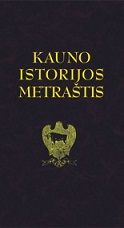Adomo Mickevičiaus namelio likimas Kaune
The Fate of “Adam Mickiewicz ’s House ” in Kaunas
Author(s): Marius VyšniauskasSubject(s): History
Published by: Vytauto Didžiojo Universitetas
Keywords: Adomas Mickevičius; Kartofliškės, Dobrovolskis; spauda, Kaunas; A. Mickevičiaus namelis; Adam Mickiewicz; Kartoliškės; Dobrovolskis; press; Kaunas; A. Mickiewicz’s house
Summary/Abstract: A Lithuanian-Polish poet Adam Mickiewicz (1797-1855) has long been regarded as the national poet of Poland and a deeply revered figure in Lithuania. Monuments to Mickiewicz began to be built after his death in Constantinople (now Istanbul). In 1890, his remains were disinterred, transferred to Poland, and entombed in the crypts of Kraków’s Wawel Cathedral, which is shared with many of those considered important to Poland’s political and cultural history. One of the famous monuments in the provisional capital of Lithuania (Kaunas) was “Mickiewicz’s house” (demolished in 1940). After the graduation of university (1819-1823), under the terms of his university scholarship, Mickiewicz taught at secondary school, in Kaunas. Before moving to a new flat in the market square, Mickiewicz lived for some time in the house, which belonged to Stanislovas Dobrovolskis, the director of Kaunas secondary school. The focus of this article is the fate of “Mickiewicz’s house” in 1890-1940, when it belonged to the last descendant of Dobrovolskis (his granddaughter Alexandra Dobrovolskytė- Vasiljevienė). One of the most important and topical goals of the societies (Lithuanian and Polish) of those times was to prove that Mickiewicz lived in Dobrovolskis’ house. A Lithuanian writer and literary critic Bičiūnas wrote in many Lithuanian newspapers that Mickiewicz did not live in this house, thus it had to be demolished. On the other hand, a Polish activist Bohdan Paszkiewicz, drawing on the information from memoirs and witnesses, tried to prove that the poet lived in the house. In 1925, there were attempts to establish a museum of Mickiewicz, following the tradition of Western Europe. However, Kaunas government did not have enough money to buy the house from the owner. The poet’s house was also very popular among the Polish tourists. When the Polish organisation Pochodnia attempted to buy the house, Lithuania did not agree due to the tense relationship between Lithuania and Poland after the Vilnius’ annexation and incorporation into Poland in 1922. The quarrels over the house were especially politicized as reflected in the press of both countries. Being in an especially bad state and impeding the traffic, the house was finally bought from Dobrovolskytė-Vasiljevienė and demolished.
Journal: Kauno istorijos metraštis
- Issue Year: 2013
- Issue No: 13
- Page Range: 273-290
- Page Count: 14
- Language: Lithuanian

